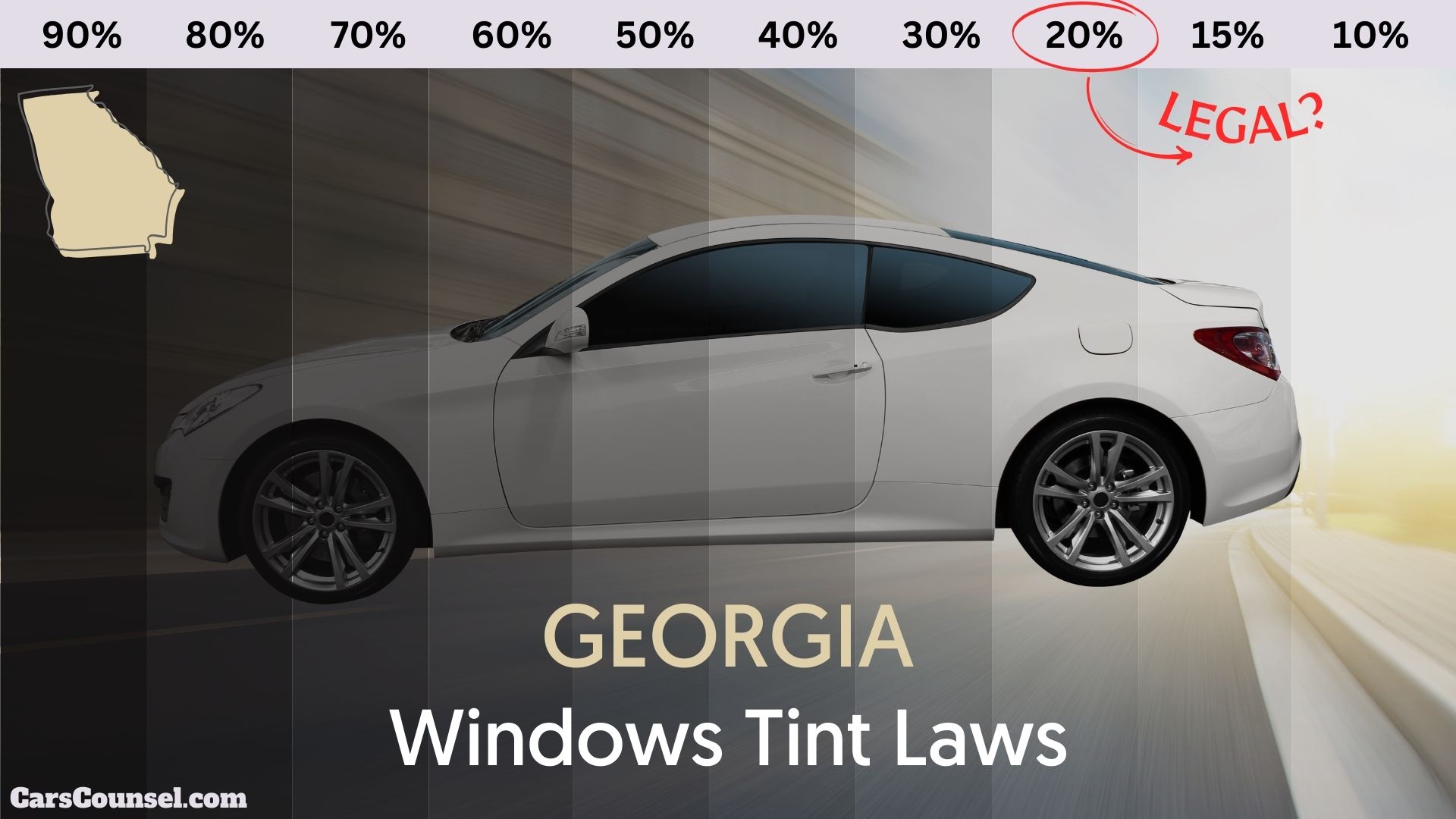You might be surprised to learn that Georgia has specific laws governing the level of darkness and reflection allowed on your vehicle’s windows. While you may think your tinted windows are just a cosmetic upgrade, failure to comply with these regulations can result in hefty fines and even imprisonment.
But what exactly are these laws, and how do they vary depending on your vehicle type and specific medical conditions? Understanding these regulations is vital to avoid penalties, and it’s time to get informed about the rules of the road – literally.

Quick Navigation
Georgia Window Tint Laws Explained
When driving through Georgia, it’s essential to understand the state’s window tint laws to avoid potential fines and penalties.
Georgia window tint laws dictate that your front windshield can only have a non-reflective tint on the top six inches, allowing more than 32% of light transmission.
Side windows on sedans must have a VLT of more than 32% and a reflectance of no more than 20%.
SUVs and vans have no restrictions on rear side windows and rear windshields.
Medical exemptions are available for individuals with certain conditions, requiring a state-licensed physician or optometrist to attest to the need for special sun shielding.
Guarantee you comply with Georgia’s state laws to avoid fines of up to $1,000 and/or imprisonment.
[carscounsel_tint_calculator show_state=”true” default_state=”GA”]
Window Tint Darkness and Reflection
Understanding Georgia’s window tint laws is vital, and a key aspect of compliance involves grasping the nuances of window tint darkness and reflection.
In terms of window tint darkness, you need to guarantee your vehicle meets the visible light transmission (VLT) requirements.
- Sedans must have a VLT of more than 32% on all windows, including the front side windows, back side windows, and rear window.
- SUVs and vans can have any darkness on the back side windows and rear window, but must still meet the 32% VLT requirement on the front side windows.
- The state of Georgia allows a 3% light transmission tolerance, meaning a tint with a VLT of 29% to 35% would be considered legal.
Additionally, your vehicle’s windows mustn’t be more than 20% reflective, and non-reflective tint is allowed on the top 6 inches of windshields.
In the realm of window tint reflection, you need to certify that your vehicle meets the requirements.
In regard to window tint darkness and reflection, understanding these laws is vital.
Vehicle Type-Specific Tint Regulations
In Georgia, different vehicle types are subject to distinct window tint regulations, and it’s crucial to recognize these variations to guarantee adherence.
As a vehicle owner, you need to understand the specific rules for your vehicle type.
For sedans, including hatchbacks, coupes, and station wagons, a minimum of 32% VLT is required on the front side windows, back side windows, and rear window.
Multipurpose vehicles, such as SUVs, vans, and trucks, have similar regulations, but with differences in rear windows.
The front windshield can have non-reflective tint on the top 6 inches, but no tinting is allowed on the rest of the windshield.
It’s essential to check with local authorities for specific window tint laws and regulations in your area.
Medical Exemptions and Fines
You may be eligible for a medical exemption to Georgia’s window tint laws if you have a specific medical condition that requires additional protection from the sun.
In such cases, you can install window tints with a Visible Light Transmission (VLT) of 23%, which is darker than the standard 32% VLT allowed for non-exempt vehicles. To qualify, you’ll need a state-licensed physician or optometrist to attest to your need for special shielding from the sun.
If you’re found to be in violation of Georgia’s tinting laws, you may face the following penalties:
- A fine of up to $1,000
- Up to 12 months imprisonment
- The violation is considered a misdemeanor and is punishable by law
Window Tint Installation and Enforcement
Most vehicles on Georgia’s roads have their windows tinted to some degree, and it’s essential to guarantee that these installations conform with the state’s regulations.
When installing window tint, you must verify it meets Georgia’s window tinting laws. The tint should allow at least 32% visible light transmission (VLT) on all windows, excluding the windshield’s top 6 inches.
Certified film manufacturers will provide you with a certificate stating the VLT percentage. The Georgia DMV doesn’t issue permits for tinted windows, so it’s your responsibility to certify.
Law enforcement will check your vehicle’s tint during routine traffic stops. If your side windows don’t meet the VLT requirement, you might face fines, even with medical exemptions.
Tint Law References and Resources
Georgia’s window tinting laws are backed by specific references and resources that provide detailed information on the regulations and exemptions.
As you navigate the state’s window tint regulations, it’s essential to consult these resources to guarantee compliance.
You can find detailed information on Georgia window tinting laws in the following resources:
- Georgia Code section 40-8-73.1, which outlines the state’s window tinting laws, including restrictions on light transmission and reflectance.
- The State of Georgia Amended Window Tint Laws, which provide detailed information on exemptions, fines, and enforcement of window tint regulations.
- The Georgia Department of Public Safety (DPS) website, which offers information on window tint permits and medical exemptions.
These resources will provide you with a comprehensive understanding of Georgia’s window tint regulations, including medical exemptions, light transmission requirements, and enforcement procedures.
Understanding Window Tinting Basics
Venture into the world of window tinting and uncover the fundamentals that govern this automotive accessory.
As you probe into high-quality window tinting, you’ll discover that window tinting laws regulate the level of tint darkness allowed on your vehicle’s windows.
These laws vary by state, with some states permitting darker tints and others being more restrictive.
Medical exemptions may also apply, allowing individuals with certain conditions to install tints that wouldn’t normally be permitted.
In regards to automotive window tinting, light transmission is a critical factor, as it affects the amount of visible light that enters your vehicle.
Understanding these basics will help you navigate Window Tint Laws, particularly in regards to tinting your side windows.
Tint Law References
Georgia Code section 40-8-73.1: Tinting of windows or windshields
State of Georgia – Amended Window Tint Laws
Medical Exemption Info
Window tint medical exemption form (.pdf file)
Car Window Tinting Laws By State
Click on the state you’re interested in for a complete guide to its tint laws and regulations. If you spot any errors, let us know through our contact page.
| State | Front Side Windows | Back Side Windows | Rear Windows | Windshield |
|---|---|---|---|---|
| Alabama | 32% | 32% | 32% | 6 inches |
| Alaska | 70% | 40% | 30% | 5 inches |
| Arizona | 33% | ANY | ANY | tinting allowed to the top of the manufacturer’s as-1 line |
| Arkansas | 25% | 25% | 10% | 5 inches |
| California | 70% | ANY | ANY | 4 inches |
| Colorado | 27% | 27% | 27% | 4 inches |
| Connecticut | 35% | 35% | ANY | non-reflective tint above the as-1 line top 6 inches |
| Delaware | 70% | ANY | ANY | non-reflective tint above the as-1 line top 6 inches |
| Florida | 28% | 15% | 15% | non-reflective tint above the as-1 line |
| Georgia | 32% | 32% | 32% | 6 inches |
| Hawaii | 35% | 35% | 35% | Non-reflective tint is allowed on the top 4 inches of the windshield |
| Idaho | 35% | 20% | 20% | non-reflective tint above the as-1 line |
| Illinois | 35% | 35% | 35% | 6 inches |
| Indiana | 30% | 30% | 30% | non-reflective tint above the as-1 line |
| Iowa | 70% | ANY | ANY | non-reflective tint above the as-1 line |
| Kansas | 35% | 35% | 35% | non-reflective tint above the as-1 line |
| Kentucky | 35% | 18% | 18% | non-reflective tint above the as-1 line |
| Louisiana | 40% | 25% | 12% | non-reflective tint above the as-1 line top 6 inches |
| Maine | 35% | 35% | 35% | top 4 inches |
| Maryland | 35% | 35% | 35% | top 5 inches |
| Massachusetts | 35% | 35% | 35% | top 6 inches |
| Michigan | 35% | ANY | ANY | top4 inches |
| Minnesota | 50% | 50% | 50% | Top 6 inches |
| Mississippi | 28% | 28% | 28% | non-reflective tint above the as-1 line top 5 inches |
| Missouri | 35% | ANY | ANY | non-reflective tint above the as-1 line top 6 inches |
| Montana | 24% | 14% | 14% | non-reflective tint above the as-1 line top 6 inches |
| Nebraska | 24% | 20% | 20% | top 6 inches or as-1 line, whichever comes first |
| Nevada | 35% | ANY | ANY | non-reflective tint above the as-1 line top 6 inches |
| New Hampshire | 35% | 35% | 35% | Allowed for the manufacturer’s AS-1 line |
| New Jersey | Illegal | ANY | ANY | Top 6 inches |
| New Mexico | 20% | 20% | 20% | 5 inches or as-1 line, whichever comes first |
| New York | 70% | 70% | 70% | top 6 inches |
| North Carolina | 35% | 35% | 35% | non-reflective tint above the as-1 line top 6 inches |
| North Dakota | 50% | ANY | ANY | Top 6 inches |
| Ohio | 50% | ANY | ANY | Top 5 inches |
| Oklahoma | 25% | ANY | ANY | 5 inches or as-1 line, whichever comes first |
| Oregon | 35% | 35% | 35% | Top 6 inches |
| Pennsylvania | 70% | 70% | 70% | Top 3 inches |
| Rhode Island | 70% | 35% | 35% | non-reflective tint above the as-1 line top 6 inches |
| South Carolina | 27% | 27% | 27% | non-reflective tint above the as-1 line top 6 inches |
| South Dakota | 35% | 20% | 20% | non-reflective tint above the as-1 line top 6 inches |
| Tennessee | 35% | 35% | 35% | non-reflective tint above the as-1 line top 6 inches |
| Texas | 25% | 25% | 25% | 5 inches or as-1 line, whichever comes first |
| Utah | 43% | ANY | ANY | non-reflective tint above the as-1 line top 4 inches |
| Vermont | 70% | ANY | ANY | ILLEGAL |
| Virginia | 50% | 35% | 35% | non-reflective tint above the as-1 line top 6 inches |
| Washington | 24% | 24% | 24% | Top 6 inches |
| West Virginia | 35% | 35% | 35% | Top 5 inches |
| Wisconsin | 50% | 35% | 35% | non-reflective tint above the as-1 line top 6 inches |
| Wyoming | 28% | 28% | 28% | Top 5 inches or as-1 line, whichever comes first |

